Accessing Course Content
Can't Access Some Course Content
In many courses, all course content is available in the course outline on the Course page as soon as the course starts. However, in some courses, content becomes available at different times.
Course content might be unavailable for the following reasons.
- The course team has scheduled specific content for release on specific dates. That content becomes visible on the course outline only on the date that the course team chooses.
- Parts of the course have prerequisite content that you must complete.
- The course team has made specific course content unavailable after certain points in the course, such as after an assignment’s due date has passed or after the course end date.
Course Content with Release Dates
When course content has release dates, the content is only available on or after those dates. Many courses release content at a specific time every week.
For information about your specific course, you can check the updates on the Course page, or you can ask questions in the course discussions.
Course Content with Prerequisites
Some courses have content that only becomes available after you achieve a minimum score in another section. In the course outline, this content appears with a lock icon and the name of the section that you must complete, or prerequisite.
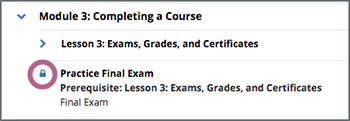
After you complete a section’s prerequisite, the section is visible in the course outline with an unlocked icon, and you can open and complete that section.
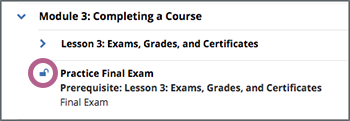
Getting Help with Assignments, Grading, or Course Content
The discussion forum is the place to inquire about assignments, quizzes, grades, and other course content. Your course's discussion forum is monitored by the course instructors, who have designed the course lessons and are experts in the course material.
To get to your course discussion forum click the link at the top of the page within your course.
Common questions or issues that can be answered by the course team on the discussion forum include the following:
- I need help with third-party software needed for my course, such as Microsoft Excel or Jupyter.
- I need help finding a specific lesson or handout.
- I believe I've found a mistake or wrong answer in the course content.
You can also find information about a specific course or topic by searching our course catalog and reading the course information page.
Note: UC San Diego Online is not able to provide direct contact information for professors, teaching assistants (TAs), or other course staff.
How To Start a Course
After you enroll in a course, the course is visible on your Courses page.
You will see the start date below the course name.

About Assignments and Exams in a Course
The types and number of assignments vary by course. Most courses do not have just a single quiz or exam to pass, but instead have many assignments throughout the course. If you finish the course with at least the minimum passing score, and you are enrolled to earn a Statement of Accomplishment, then you will earn the Statement of Accomplishment.
The minimum passing score also varies by course. You can see the minimum score for a particular course on the progress page. This is the line between the gray and white sections on the progress graph.
Return to Where You Were Working
You can return to the unit that you completed most recently in any UC San Diego Online course, or in a specific course. A unit is complete when you have completed all of the following actions:
- Watch all videos.
- Submit answers to all problems.
- View all text or other content for at least five seconds.
- Mark the unit complete, when required.
Return to the Most Recently Completed Unit in Any Course
To return to the unit you completed most recently in any of your UC San Diego Online courses, select the arrow next to your username on any UC San Diego Online page, and then select Resume your last course.
The course that you were most recently working in opens to the unit that you most recently completed.
Return to the Most Recently Completed Unit in a Specific Course
To return to the unit you completed most recently in a specific UC San Diego Online course, you have the following options.
- On your Courses page, locate your course, and then select Resume Course next to the social media sharing options.
- Open the course, and select Resume Course on the Course page.
When you select Resume Course, the course opens to the unit that you most recently completed.
Finding Course Handouts
In many courses, additional documents are available in the Course Handouts section. This is on the far right side of the main course page.
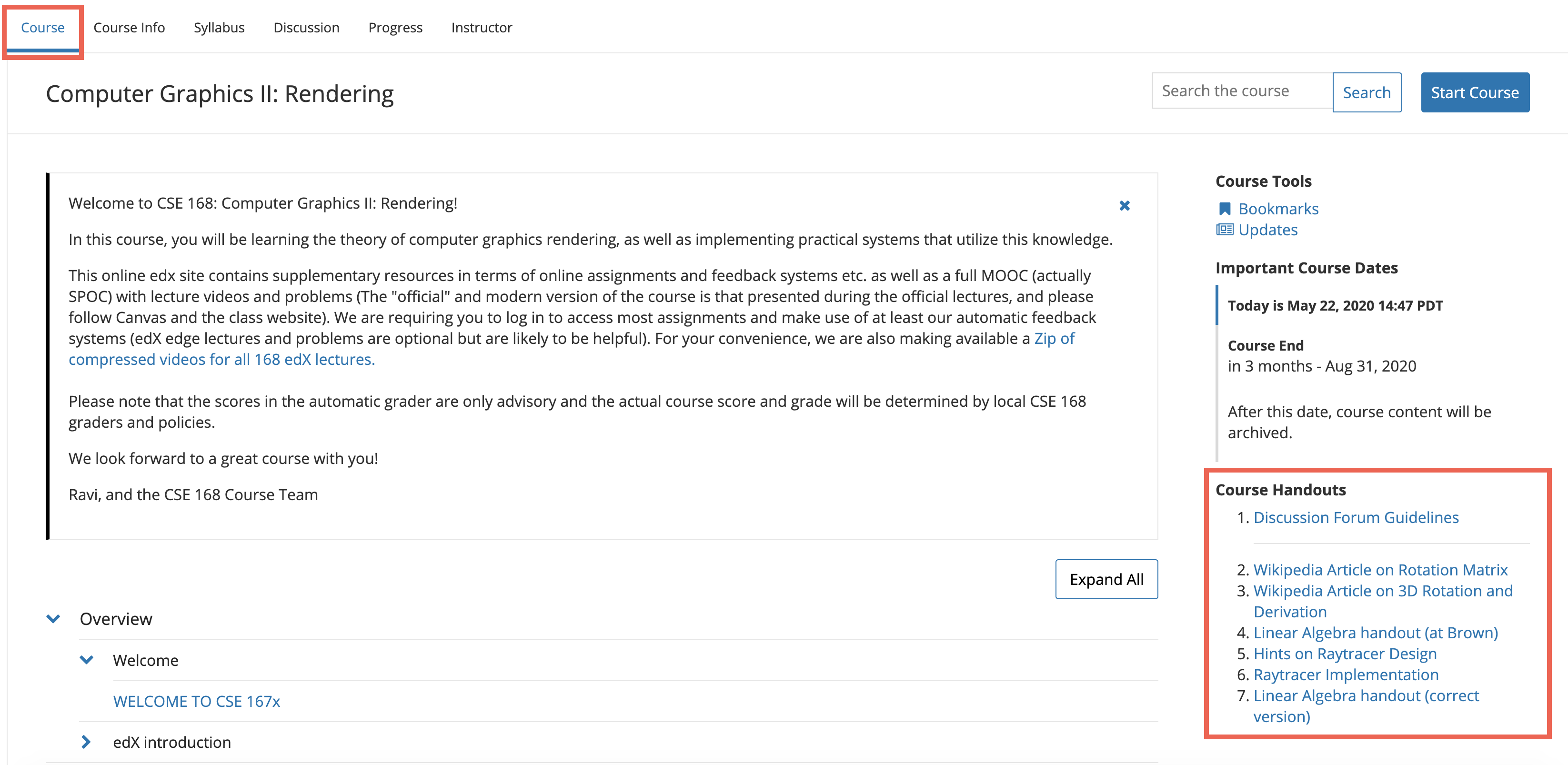
Downloading Course Materials
UC San Diego Online courses are fully online and can be accessed through the UC San Diego Online platform. It is not possible to download a course, but in some courses, you'll find links to download lecture videos underneath the video player window.
Most UC San Diego Online courses do not have a "textbook" and instead have any required reading within the course itself.
Courses share reading materials in different ways; your course team should provide you with information. Some courses provide links to reading materials in the Course Handouts section. This is on the far right side of the main course page.Bookmark a Page in a Course
You can set a bookmark on any page in the course so that you can easily come back to it later.
Note: You can create up to 100 bookmarks for any one course.
Add a Bookmark
You can add a bookmark by selecting Bookmark this page below the name of the page.

After you add a bookmark, Bookmark this page changes to Bookmarked, and a bookmark indicator appears in the unit navigation bar at the top of the page.

Remove a Bookmark
To remove a bookmark, select Bookmarked.
View Your Bookmarks
You can view your saved bookmarks by selecting the Bookmarks link in the Course Tools menu on the right side of the page. Bookmarks are listed in the order they were created, and include a location to the course material and the date that you added the bookmark.

Sharing on Social Media
You can share the courses you are enrolled in on social media sites such as Facebook and Twitter.
To share your course on social media
- Find the listing for the course that you want to share, and click on the course card to open the course About page.
- On the course About page, select the icon for the social media site where you want to share your course. If you are not already signed in to that social media site, you will be prompted to sign in.
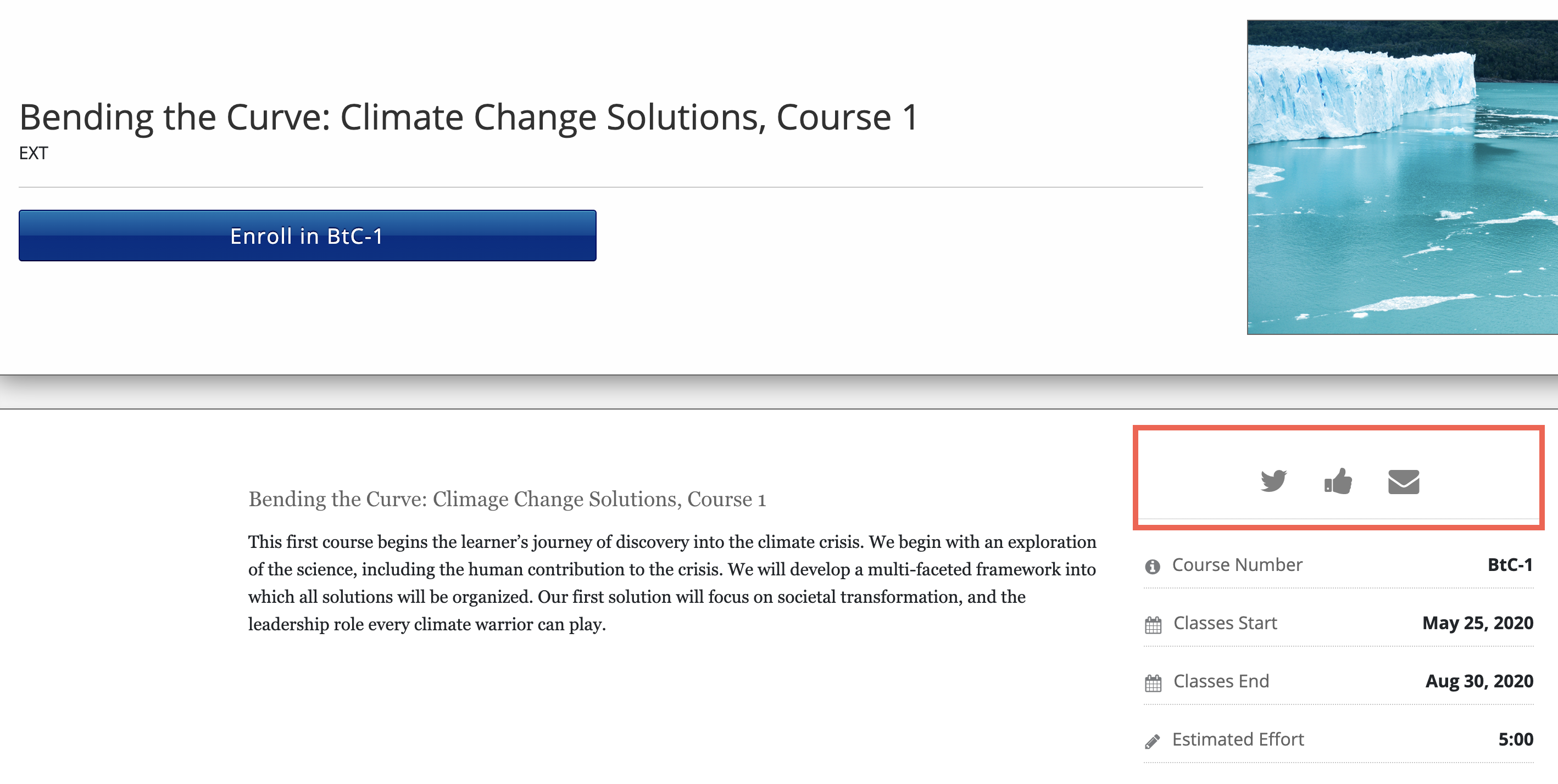
- A dialog box for the social media site opens, with the course URL entered and a default social media message. If desired, modify the text of the social media message to personalize your post or tweet.
- Select the appropriate Post or Tweet button to publish your message on the social media site.
Viewing Course Content Offline
To complete assignments and view the majority of our course content you need an active internet connection.
Some courses do offer downloadable videos and transcripts which you can view offline. Look to the lower left corner of the video window in a course and there you will see the download options, if they are available.
Watching Videos on the Video Player
All UC San Diego Online courses include videos. Most of the controls on the video player will be familiar to you if you have watched online videos before. However, the video player on UC San Diego Online has some extra features you may not have seen.
The following image shows the video player in the middle of a video, followed by an explanation of each option or control on the video player.
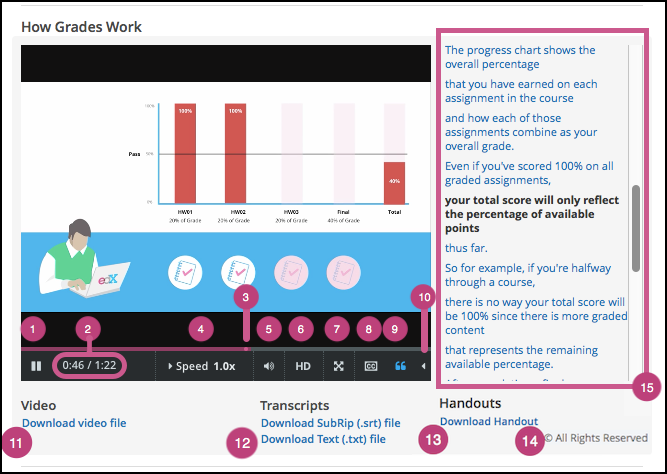
- Play/pause : You can play the video by clicking this control. Click this control again to pause the video.
- Time : The first number indicates the length of time the video has already played. The second number indicates the total length of the video.
- Playback bar : You can go to a different point in the video by selecting and dragging this control or by using the left and right arrow keys.
- Speed : If you want the video to play faster or slower, you can select different speeds using this control.
- Volume : You can use this control to change the volume of the video.
- HD : You can play the video in high-definition visual resolution by selecting this option if HD quality is available for the video. This option works best if you have a fast Internet connection. Click this control again to play the video in standard resolution.
- Full screen : You can expand the video to fill your browser window by clicking this control. To return to default mode, press ESC on your keyboard or click this control again.
- Show or hide closed captioning : You can show an overlaid transcript of the audio portion of the file by clicking this control. If you show the captions, you can move them to different areas on the video screen by dragging and dropping them. To hide the captions, click this control again.
- Show transcript : You can show a complete, scrolling transcript of the audio portion of the file to the right of the video by click this control. Many course teams set video transcripts to play by default when your video starts. Click this control again to hide the transcript.
- Language menu : If translations are available, you can select a different language for the closed captions and the transcript using this control.
- Download video : You can download the video to watch later with this option (if available for the video).
- Download transcript : You can download the video’s transcript as a SubRip (.srt) file or as a text (.txt) file. You can open files of either type in a text editor such as Notepad.
- Handouts : You can download any handouts that the course team has associated with the video.
- License or Copyright : If the course team reserves rights or specifies a Creative Commons license for the video that is different from the course-wide license, that information appears below the video player. For Creative Commons licenses, you can select the license to open a website with more information about your rights.
For more information, see Understanding How Courses and Videos Are Licensed . - Transcript: You can scroll through the transcript and select any line to go to that point in the video.
Understanding How Courses and Videos are Licensed
The course author can specify licensing options for course content, as well as for each video in the course. The course and video licenses specify whether and how you can reuse course content.
All Rights Reserved
All Rights Reserved indicates that the course author owns the copyright but reserves all rights for sharing copies of course content or videos. You cannot reuse or republish course content or videos that have All Rights Reserved licenses.
Viewing Licenses
If the course author has set a license for the course, you see the license at the bottom of the page when you view content in the Course tab. If a video has a different license than the course as a whole, you see the license at the bottom right of the video player.
Creative Commons License
The Creative Commons license indicates that the course author owns the copyright but is granting certain permissions for reuse, depending on the license options selected by the course team.
A Creative Commons license has one or more of the following options:
- Attribution: This option allows you to copy, distribute, display, and perform copyrighted work but only if they give credit the way you request. This option is always selected for UC San Diego Online courses and videos under a Creative Commons license.
- Noncommercial: This option allows you to distribute, display, and perform work–and derivative works based upon it–but for non-commercial purposes only.
- No Derivatives: This option allows you to distribute, display, and perform only verbatim copies of the work, not derivative works based upon it. This option cannot be in use with the Share Alike option.
- Share Alike: This option allows you to distribute derivative works only under a license identical to the license that governs the work. This option cannot be in use with the No Derivatives option.
For more information, see the Creative Commons website.
Video Transcripts and Captions
UC San Diego Online course videos created by the course team have interactive transcripts as well as closed captions. In some courses, the transcripts can also be downloaded.
Turn on Interactive Transcripts
You can turn on interactive transcripts for a video by clicking the button in the lower right corner of the video player. Interactive transcripts appear to the right of the screen, and keep pace with the video as it plays.
Turn on Closed Captions
You can turn on closed captions by clicking the closed caption ( CC ) button. Closed captions appear along the bottom of the video.
Download Transcript Files
Many courses offer downloadable transcripts in SubRip (.srt) or text (.txt) file formats. You can access the transcripts by clicking the download options below the video window.

SubRip (.srt) files can be opened by most word processor programs and browsers. Please note that .srt files include time information. If you prefer to download a file without the time information, choose the .txt format. This format does not include time data, and therefore might be easier to read.
To download a video transcript, below the video player, select the download option for the transcript file format that you want. In the dialog that opens, you can choose to open or save the transcript file.
For more information about course videos and the UC San Diego Online video player controls, see Watching Videos on the Video Player.